|
|

|
|
Author
|
Topic: Space Cover 592: NASA STDN Madrid
|
Eddie Bizub
Member Posts: 100
From: Kissimmee, FL USA
Registered: Aug 2010
|
 posted 01-02-2021 09:22 PM
posted 01-02-2021 09:22 PM
   
Space Cover of the Week, Week 592 (January 3, 2021)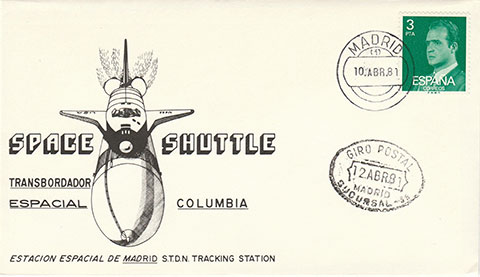 Space Cover #592: NASA STDN Madrid SpainFollowing slightly on Antoni's lead from his Space Cover post from last week, my choice this week is to highlight a few covers I recently picked up. These are tracking covers for each of the first three space shuttle launches. These are postmarked in Madrid, Spain, which is home to one of the large dishes of NASA's Deep Space Network. The Deep Space Network dishes are used to communicate with various probes throughout the solar system. They were also used to track various space launches and to communicate with orbiting spacecraft before the Tracking and Data Relay System satellites came online. The first cover pictured is for STS-1, the first space shuttle launch. The cover has a Madrid postmark for what was the scrub date of April 10 and then a second cancel for the launch date of April 12. 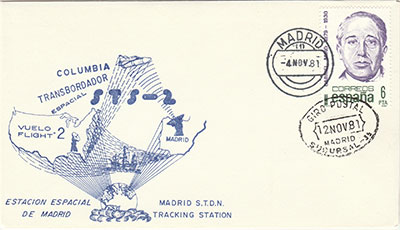 The second cover is for STS-2 and again has a cancel for the scrub date of November 4 and a second cancel for the launch date of November 12. 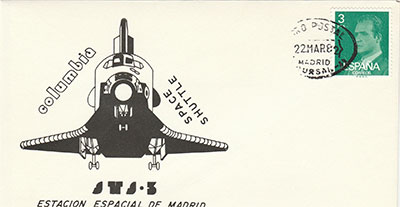 The third cover pictured is for the STS-3 launch. Each of the three covers pictured has a very nice printed cachet. Typically with tracking station covers they apply an appropriate rubber stamp cachet or corner card but these are very nice printed cachets. They look like they were done by maybe a local stamp club or something similar. Does anyone have any information on who may have done these covers? Also, any info on the different cancels or why they were postmarked for the scrub dates would be appreciated. |
MarylandSpace
Member Posts: 1382
From:
Registered: Aug 2002
|
 posted 01-03-2021 11:40 AM
posted 01-03-2021 11:40 AM
   
Nice looking covers and nice, gentle cancellations. Thank you for sharing. |
eurospace
Member Posts: 2635
From: Berlin, Germany
Registered: Dec 2000
|
 posted 01-03-2021 07:49 PM
posted 01-03-2021 07:49 PM
   
I have no details about who produced these covers in Madrid. Antoni might have more information here.However, I think I have a pretty accurate clue why there were cancelled with the scrub date. Well, usually launches take place in a different time zone. So the scheduled launch date is probably outside of opening hours of the post office. Post offices might be reticent to back date the covers. So if the launch is scheduled probably an hour after the post office closes, you would probably to there an hour before it closes and get your covers cancelled. Bad luck then if the launch is then cancelled just an hour after your covers were cancelled. What will you do? Not throw the covers away, too expensive. Nobody would buy covers from a scrubbed date either. So you use the same covers again, go with them to the post office again, and then be more lucky. Covers saved, correct launch date was used, and collectors would still accept them.
|
Antoni RIGO
Member Posts: 213
From: Palma de Mallorca, Is. Baleares - SPAIN
Registered: Aug 2013
|
 posted 01-04-2021 04:55 AM
posted 01-04-2021 04:55 AM
   
Thanks Eddie for showing some of these Spanish space covers which I widely known because its creator told me the story several times.Printed covers were produced by José Manuel Grandela in quantity of around 200 copies each one. No exact figures can be provided because invoices issued by printing were not kept. At that time domestic printers did not exist and covers had to be taken to print shop. Mr. Grandela, former INTA-NASA employee at Fresnedillas, and later at Robledo (both tracking stations in Madrid province) was a Spanish astrophilatelist, exhibitor, Astro Spanish Chairman until 2010, Astro FIP Secretary and finally became Astrophilately FIP Chairman in period 2000-2008. Currently retired from major philatelic events, he just offers some conferences and writes some articles. Next to these printed covers there are too RSC covers created by Mr. Grandela. Neither exact figures can be provided because these covers were produced on request. So, maybe for some missions copies of RSC are only around 50 meanwhile others +200. See an example for STS-1 mission with RSC produced by Mr. Grandela (left) and RSC from NASA comm (right). 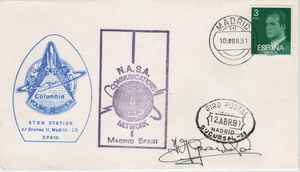 Furthermore, printed covers can found as shown by Eddie in first post, but also with RSC applied on front side, or applied on backside. See both examples. 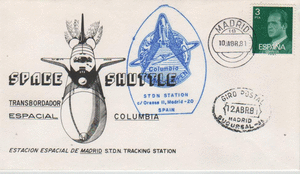 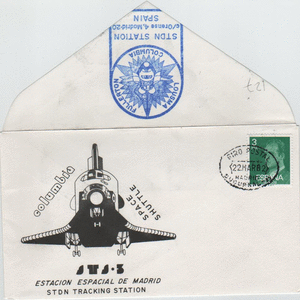 Concerning scrub dates. Printed covers were delivered at the post office on advance of launch scheduled date with a note like this: "to be postmarked on x date." However, for STS-1 and STS-2 launch scheduled dates were postponed and new launch dates were assigned. It happened without knowledge of the post office what postmarked the covers on requested day. When Mr. Grandela realized that their covers were already postmarked with the scrub dates (as told by Jürgen, nobody wants to lose their space covers) then he took the option to request a second postmark with correct launch date. Obviously this was the cheapest solution. Others would be by applying a second stamp on each cover (cost) or print again all the covers with other stamps (more cost). In order to solve this situation, from STS-3 onwards, all printed covers delivered on advance at post office were accompanied with a note like this: "no postmark until I called with specific date." I hope this info could be helpful.
|
Ken Havekotte
Member Posts: 3153
From: Merritt Island, Florida, Brevard
Registered: Mar 2001
|
 posted 01-04-2021 01:48 PM
posted 01-04-2021 01:48 PM
   
Great feedback posting Antoni with all of that philatelic knowledge and information about the Spanish Spaceflight Tracking & Data Network (STDN) station in Madrid. The Madrid tracking station was one of four shuttle program operated STDN sites that provided critical support for Columbia's OMS orbital phase insertion with tracking, telemetry, air-ground and command support to Mission Control Center at NASA's Johnson Space Center in Houston. I'm checking over my own Madrid shuttle launch tracking station covers and came across an unusual issue seen below. I would assume the shuttle tracking chart full-cachet cover was mailed over to the Madrid station for processing for the second shuttle mission (STS-2) launched on Nov. 12, 1981. The chart cover itself came from an original printed NASA shuttle orbital mission chart for Mission STS-2. On the back side of the chart-map cover is an applied rubber stamp cachet in green ink, which I believe, was provided by the station itself, or, was it provided by a German space cover dealer? It depicts the STS-2/Columbia crew emblem along with the station's address. But my favorite component of the chart cover can be seen on the front surface to the left of the cachet. Here it actually shows the STDN station at Madrid in Spain labeled as "MAD," an appropriate connection with the cachet tie-in to the actual space cover event itself. Of course, while not a direct Madrid-printed cover issue, it does provide an appropriate connection in my opinion.  |
Eddie Bizub
Member Posts: 100
From: Kissimmee, FL USA
Registered: Aug 2010
|
 posted 01-04-2021 11:11 PM
posted 01-04-2021 11:11 PM
   
Antoni, thank you so much for the info! That's great stuff. My STS-3 does have the rubber stamp cachet on the back. I also have an STS-9 which looks printed and an STS-27 that looks like an elaborate rubber stamp. Do you know how many flights were covered? |
Ken Havekotte
Member Posts: 3153
From: Merritt Island, Florida, Brevard
Registered: Mar 2001
|
 posted 01-05-2021 04:50 AM
posted 01-05-2021 04:50 AM
   
So here is a quick question for tracking station cover specialists Antoni, Eddie, and Juergen; Were the various shuttle emblem rubber stamp cachets provided by the Madrid station itself by Mr. Grandela?I do recall seeing during the early shuttle program years similar affixed rubber stamps on Madrid covers along with a few other worldwide STDN stations that had been provided by European dealers. Throughout the 1980's I had been under the impression by a German space cover dealer (and I can't recall his name now) that perhaps many of those crew emblem rubber stamps were add-ons by their firms, however, that was a long time ago and perhaps they had been provided "on site" in Spain by Mr. Grandela as Antoni indicated. Perhaps Antoni can confirm either way? |
Antoni RIGO
Member Posts: 213
From: Palma de Mallorca, Is. Baleares - SPAIN
Registered: Aug 2013
|
 posted 01-05-2021 10:49 AM
posted 01-05-2021 10:49 AM
   
Wow, I never thought NASA Madrid space covers would be so interesting!!!Sorry guys, I have not a clear and blunt answer to each of your questions, many of them I have already asked myself in the past. Ken, all info supplied about MAD tracking station is absolutely true. Congratulations for supporting us once again about astronautics history. I am agree with you that this map cover is very appropriate (image location and postmark matching). I have the same cover but with same green RSC applied on the front side. I am not sure 100% if all RSC applied on Spanish space covers were produced by Mr. Grandela as he did not keep any kind of record. However, I can say that many of RSC with Spanish text or text English/Spanish were produced by Mr. Grandela. In Fresnedillas (where NASA tracking station was located until 1985) there is a "Museo Lunar" (Moon Museum) where some RSC are displayed. At least what is displayed, was always in Spain and never came out. I should search into my files if I have some photo of some of these RSC there displayed. As Mr. Grandela received many commitments of other astrophilatelists, it is possible to find covers produced around the world with some of its RSC applied on them. He offered it as favour to other collectors orfor swapping space covers. As long I know, Mr. Grandela worked with Robert Rank (SpaceVoyage firm) and for this reason this kind of covers can be found with Spanish postmarks. He also collaborated with some German dealers/collectors but not sure if was just with Eberhard Cölle or another person. When I asked him for this issue, he did not remember. Answering to Eddie, last covers I have produced by Mr. Grandela are dated in 1992, when he left to do it. I am not sure if STS-46 was the last mission (it is the last mission I have though). If anyone has Spanish covers later than STS-46 I would be grateful to see them. Ken, there are a lot of Spanish space covers with RSC (probably produced by Mr. Grandela) as well as other RSC (official or private). An example can be seen in my previous post. There is not a clear sign of identification for Grandela's covers. As told before, printed cachets covers shown by Eddie, can be found with/without RSC. Also Spanish covers with more than 1 RSC or map covers (clearly not produced in Spain) with RSC. Sorry again if all this seems a bit complicated. Many years ago I thought in doing a catalog for all Spanish space covers but I gave up due to great difficult in finding clear answers. |
Ken Havekotte
Member Posts: 3153
From: Merritt Island, Florida, Brevard
Registered: Mar 2001
|
 posted 01-05-2021 05:06 PM
posted 01-05-2021 05:06 PM
   
Certainly, Antoni, no problem at all with all of your provided answers to the many questions. You did great in trying to answer what you could--but--while I have never really been an avid space tracking station cover collector in the first place, I do find some of them fascinating.But recently, though, while sorting over dozens of cover boxes, I did come across a lot of tracking station cover issues that I wasn't fully aware of. Many of the covers acquired were from purchased space cover collections over the years that I was able to pick up, and some, with very large quantities that included hundreds of station covers that did intrigue me somewhat. I think someone did ask in an earlier post of when the Madrid station had deactivated its 85-foot antenna, named "Dino." That was in 1985 after two decades of space flight telemetry service for NASA and the U.S. military since the Gemini program in 1965. The "MAD" station site in Spain is one of three Deep Space Network (DSN) stations still in operation today. It was this very same station that relayed the first TV images of Armstrong stepping on the moon in 1969 and was critical in brining the Apollo 13 crew back home nine months later. In addition, the Spanish station complex was a key deep space network facility for the Mariner 4 fly-by of Mars, Mariner 10 to Mercury and Venus, and for the twin far-out Voyager space probes now in interstellar space. There are plenty of Madrid tracking covers out there for such planetary and deep space events. Perhaps Buzz Aldrin said it well of all the tracking station "Range Rats," as he called them, "I salute--from my space helmet--the unsung heroes of the space race to the future." Thanks for the topic starter, Eddie.
|
Eddie Bizub
Member Posts: 100
From: Kissimmee, FL USA
Registered: Aug 2010
|
 posted 01-05-2021 10:59 PM
posted 01-05-2021 10:59 PM
   
Thank you Antoni!!! I really like these covers and will be on the lookout for more. |
Ross
Member Posts: 491
From: Australia
Registered: Jul 2003
|
 posted 01-06-2021 08:19 AM
posted 01-06-2021 08:19 AM
   
One small correction to Ken's otherwise excellent articles. The Spanish DSN station did not broadcast Armstrong's first step as it had just gone out of range before Armstrong's EVA. Armstrong started his EVA early which meant that the only stations that could receive the signal were Honeysuckle Creek just outside of Canberra, Australia and Goldstone in California, USA. However, the Goldstone signal was a little grainy and so. at the last moment,as Armstrong was climbing down the ladder, NASA changed to the superior Honeysuckle Creek signal to broadcast the first step to the world. However, as soon as the Parkes dish in NSW, Australia was in-line-of-site contact with Apollo 11, NASA switched the TV signal to the superior Parkes broadcast.It also meant that Australians were the first to see, by a second or so the first step as the Honeysuckle Creek signal was siphoned off to Australian TV networks before being sent to Goldstone. |
Ken Havekotte
Member Posts: 3153
From: Merritt Island, Florida, Brevard
Registered: Mar 2001
|
 posted 01-06-2021 09:36 AM
posted 01-06-2021 09:36 AM
   
Very good Ross! My notes in my media section of DSN stations also stated that there had been a change of signal coverage and that Canberra was also involved with Apollo 11's first EVA, however, my notes indicated that the big 26-meter antenna was the main station in Spain for the "first foot lunar touch." Appreciate the correction as my notes came from a station communications engineer, however, let me try to see why he reported that assumption. |
Antoni RIGO
Member Posts: 213
From: Palma de Mallorca, Is. Baleares - SPAIN
Registered: Aug 2013
|
 posted 01-09-2021 02:38 PM
posted 01-09-2021 02:38 PM
   
As I heard the story told many years ago to a Spanish engineer who worked in MAD tracking station, Apollo 11 timeline was as follows: - Eagle landed on Moon when signal was received first in Fresnedillas (MAD) and then sent to Houston.
- Armstrong coming down the Eagle and posing his foot on the Moon through signal received by Honeysucke tracking station.
In between two space events it passed +6 hours and Madrid had already lost the signal with Apollo 11.So, Armstrong and Aldrin did not left Eagle immediately after Moon landing. According procedures, they should assure the spaceship as well as put on your spacesuits, which took them quite a while. However, I heard too that time between Eagle landing and Armstrong EVA was to wait for "prime time" in USA (TV frame period of maximum audience). But maybe this last is just a rumor that time turned into something more like a truth. |
Antoni RIGO
Member Posts: 213
From: Palma de Mallorca, Is. Baleares - SPAIN
Registered: Aug 2013
|
 posted 01-20-2021 12:43 PM
posted 01-20-2021 12:43 PM
   
Finally I found what I told some posts above this.Photography (sorry for bad quality) shows some of the devices produced by Mr. Grandela and used in their covers. 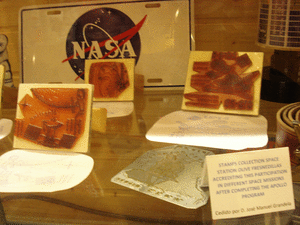 The devices were used as rubber stamp cachet as well as design for printed covers. Shown the three covers concerning the devices photographed. 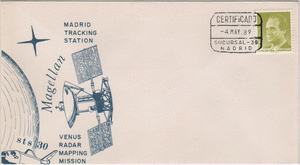
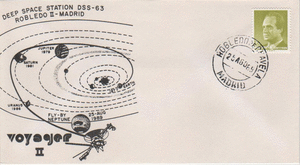
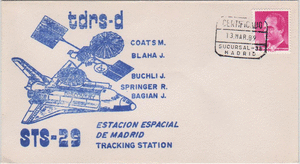 So, I can confirm that at least these three cachets were made in Spain and still are here. | |
Contact Us | The Source for Space History & Artifacts
Copyright 2021 collectSPACE.com All rights reserved.

Ultimate Bulletin Board 5.47a
|
|

|
 advertisement advertisement

|






















